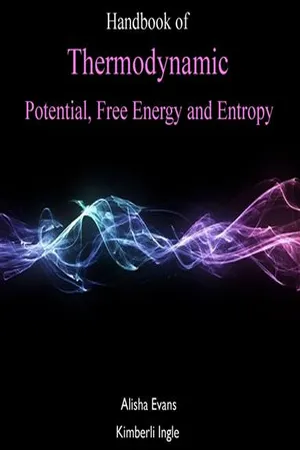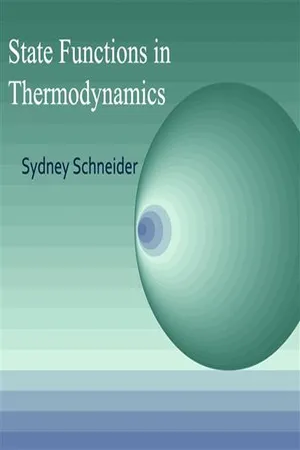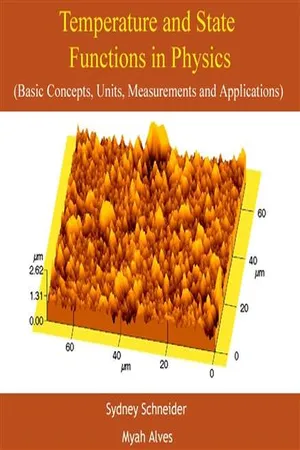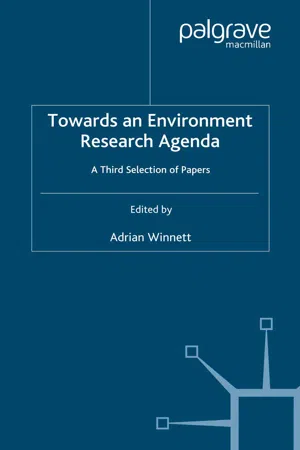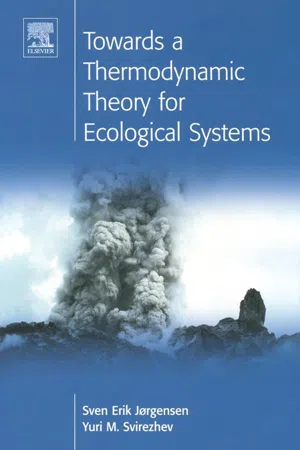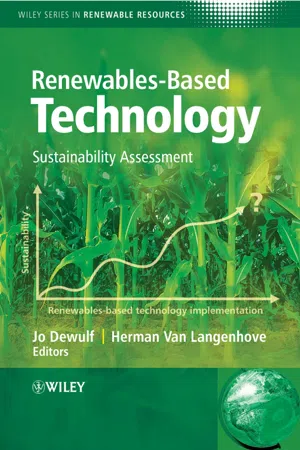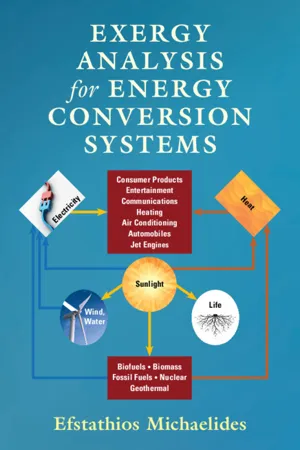Technology & Engineering
Exergy
Exergy is a measure of the maximum useful work that can be obtained from a system as it comes into equilibrium with its environment. It takes into account both the quantity and quality of energy, providing a more comprehensive assessment of energy resources and processes. In engineering, exergy analysis is used to optimize energy systems and improve efficiency by identifying and minimizing energy losses.
Written by Perlego with AI-assistance
Related key terms
1 of 5
10 Key excerpts on "Exergy"
- No longer available |Learn more
- (Author)
- 2014(Publication Date)
- Academic Studio(Publisher)
________________________ WORLD TECHNOLOGIES ________________________ Chapter 6 Exergy In thermodynamics, the Exergy of a system is the maximum useful work possible during a process that brings the system into equilibrium with a heat reservoir. When the surroundings are the reservoir, Exergy is the potential of a system to cause a change as it achieves equilibrium with its environment. Exergy is the energy that is available to be used. After the system and surroundings reach equilibrium, the Exergy is zero. Dete-rmining Exergy was also the first goal of thermodynamics. Energy is never destroyed during a process; it changes from one form to another. In contrast, Exergy accounts for the irreversibility of a process due to increase in entropy. Exergy is always destroyed when a process involves a temperature change. This des-truction is proportional to the entropy increase of the system together with its surroundings. The destroyed Exergy has been called anergy . For an isothermal process, Exergy and energy are interchangeable terms, and there is no anergy. Exergy analysis is performed in the field of industrial ecology to use energy more efficiently. The term was coined by Zoran Rant in 1956, but the concept was developed by J. Willard Gibbs in 1873. Ecologists and design engineers often choose a reference state for the reservoir that may be different from the actual surroundings of the system. Exergy is a combination property of a system and its environment because unlike energy it depends on the state of both the system and environment. The Exergy of a system in equilibrium with the environment is zero. Exergy is neither a thermodynamic property of matter nor a thermodynamic potential of a system. Exergy and energy both have units of joules. The Internal Energy of a system is always measured from a fixed reference state and is therefore always a state function. - No longer available |Learn more
- (Author)
- 2014(Publication Date)
- Orange Apple(Publisher)
________________________ WORLD TECHNOLOGIES ________________________ Chapter- 2 Exergy In thermodynamics, the Exergy of a system is the maximum useful work possible during a process that brings the system into equilibrium with a heat reservoir. When the surroundings are the reservoir, Exergy is the potential of a system to cause a change as it achieves equilibrium with its environment. Exergy is the energy that is available to be used. After the system and surroundings reach equilibrium, the Exergy is zero. Determining Exergy was also the first goal of thermodynamics. Energy is never destroyed during a process; it changes from one form to another. In contrast, Exergy accounts for the irreversibility of a process due to increase in entropy. Exergy is always destroyed when a process involves a temperature change. This destruction is proportional to the entropy increase of the system together with its surroundings. The destroyed Exergy has been called anergy . For an isothermal process, Exergy and energy are interchangeable terms, and there is no anergy. Exergy analysis is performed in the field of industrial ecology to use energy more efficiently. The term was coined by Zoran Rant in 1956, but the concept was developed by J. Willard Gibbs in 1873. Ecologists and design engineers often choose a reference state for the reservoir that may be different from the actual surroundings of the system. Exergy is a combination property of a system and its environment because unlike energy it depends on the state of both the system and environment. The Exergy of a system in equilibrium with the environment is zero. Exergy is neither a thermodynamic property of matter nor a thermodynamic potential of a system. Exergy and energy both have units of joules. The Internal Energy of a system is always measured from a fixed reference state and is therefore always a state function. - No longer available |Learn more
- (Author)
- 2014(Publication Date)
- White Word Publications(Publisher)
________________________ WORLD TECHNOLOGIES ________________________ Chapter-3 Exergy In thermodynamics, the Exergy of a system is the maximum useful work possible during a process that brings the system into equilibrium with a heat reservoir. When the surroundings are the reservoir, Exergy is the potential of a system to cause a change as it achieves equilibrium with its environment. Exergy is the energy that is available to be used. After the system and surroundings reach equilibrium, the Exergy is zero. Deter-mining Exergy was also the first goal of thermodynamics. Energy is never destroyed during a process; it changes from one form to another. In contrast, Exergy accounts for the irreversibility of a process due to increase in entropy. Exergy is always destroyed when a process involves a temperature change. This destruction is proportional to the entropy increase of the system together with its surroundings. The destroyed Exergy has been called anergy . For an isothermal process, Exergy and energy are interchangeable terms, and there is no anergy. Exergy analysis is performed in the field of industrial ecology to use energy more efficiently. The term was coined by Zoran Rant in 1956, but the concept was developed by J. Willard Gibbs in 1873. Ecologists and design engineers often choose a reference state for the reservoir that may be different from the actual surroundings of the system. Exergy is a combination property of a system and its environment because unlike energy it depends on the state of both the system and environment. The Exergy of a system in equilibrium with the environment is zero. Exergy is neither a thermodynamic property of matter nor a thermodynamic potential of a system. Exergy and energy both have units of joules. The Internal Energy of a system is always measured from a fixed reference state and is therefore always a state function. - No longer available |Learn more
- (Author)
- 2014(Publication Date)
- Academic Studio(Publisher)
________________________ WORLD TECHNOLOGIES ________________________ Chapter 8 Exergy In thermodynamics, the Exergy of a system is the maximum useful work possible during a process that brings the system into equilibrium with a heat reservoir. When the surroundings are the reservoir, Exergy is the potential of a system to cause a change as it achieves equilibrium with its environment. Exergy is the energy that is available to be used. After the system and surroundings reach equilibrium, the Exergy is zero. Determining Exergy was also the first goal of thermodynamics. Energy is never destroyed during a process; it changes from one form to another. In contrast, Exergy accounts for the irreversibility of a process due to increase in entropy. Exergy is always destroyed when a process involves a temperature change. This destruction is proportional to the entropy increase of the system together with its surroundings. The destroyed Exergy has been called anergy . For an isothermal process, Exergy and energy are interchangeable terms, and there is no anergy. Exergy analysis is performed in the field of industrial ecology to use energy more efficiently. The term was coined by Zoran Rant in 1956, but the concept was developed by J. Willard Gibbs in 1873. Ecologists and design engineers often choose a reference state for the reservoir that may be different from the actual surroundings of the system. Exergy is a combination property of a system and its environment because unlike energy it depends on the state of both the system and environment. The Exergy of a system in equilibrium with the environment is zero. Exergy is neither a thermodynamic property of matter nor a thermodynamic potential of a system. Exergy and energy both have units of joules. The Internal Energy of a system is always measured from a fixed reference state and is therefore always a state function. - No longer available |Learn more
- (Author)
- 2014(Publication Date)
- Academic Studio(Publisher)
______________________________ WORLD TECHNOLOGIES ______________________________ Chapter 9 Exergy In thermodynamics, the Exergy of a system is the maximum useful work possible during a process that brings the system into equilibrium with a heat reservoir. When the surroundings are the reservoir, Exergy is the potential of a system to cause a change as it achieves equilibrium with its environment. Exergy is the energy that is available to be used. After the system and surroundings reach equilibrium, the Exergy is zero. Determining Exergy was also the first goal of thermodynamics. Energy is never destroyed during a process; it changes from one form to another. In contrast, Exergy accounts for the irreversibility of a process due to increase in entropy. Exergy is always destroyed when a process involves a temperature change. This destruction is proportional to the entropy increase of the system together with its surroundings. The destroyed Exergy has been called anergy . For an isothermal process, Exergy and energy are interchangeable terms, and there is no anergy. Exergy analysis is performed in the field of industrial ecology to use energy more efficiently. The term was coined by Zoran Rant in 1956, but the concept was developed by J. Willard Gibbs in 1873. Ecologists and design engineers often choose a reference state for the reservoir that may be different from the actual surroundings of the system. Exergy is a combination property of a system and its environment because unlike energy it depends on the state of both the system and environment. The Exergy of a system in equilibrium with the environment is zero. Exergy is neither a thermodynamic property of matter nor a thermodynamic potential of a system. Exergy and energy both have units of joules. The Internal Energy of a system is always measured from a fixed reference state and is therefore always a state function. - eBook - PDF
Towards an Environment Research Agenda
A Third Selection of Papers
- A. Winnett(Author)
- 2004(Publication Date)
- Palgrave Macmillan(Publisher)
Exergy is a measure of the maximum theoretical useful work obtainable from a thermal system (as it is brought into equilibrium with its surrounding environment), and this may be not be the only or relevant criterion in a particular situation. An innovative attempt to analyse different societies in terms of energy and Exergy flow diagrams has been made by Sciubba (1995). He examined the sustainability of a variety of social structures ranging from ‘primitive’ tribal groups, via industrial (and ‘post-industrial’) societies, to a future envisaged as being dominated by a highly ‘robotised’ or cybernetically controlled social organization. In essence, energy and Exergy were employed here as ‘technology level indica- tors’. Sciubba recognized that his model was an oversimplification of the complex interactions that arise between human societies and the natural world. Nevertheless, he believes this energy–Exergy approach can adequately represent these various interactions. Consequently, the model could be used to examine alternative societal arrangements that might be ‘leaner’ in terms of resource extraction, while being as ‘comfortable’ as present industrialized societies. Not all forms of soci- etal organization were found to be self-sustaining, with certain size and technology-related restrictions applying to most societies. Sciubba (1995) argues that neither resource scarcity nor biosphere capacity appears to constrain human development, although many energy analysts and environmentalists (for example, Goldemberg, 1996; Lovins, 1977; Parkin, 2000; Porritt, 2000) would suggest that the contrary is the case. Geoffrey P. Hammond 203 Ecology and ‘free energy’ In the field of ecology, strictly the branch of the natural sciences that deals with the relation between biological organisms and their physical surrounding, the concept of Gibbs free energy or function (G) is used in preference to Exergy (Haynie, 2001). - S.E. Jorgensen, Y.M. Svirezhev(Authors)
- 2004(Publication Date)
- Pergamon(Publisher)
Chapter 5Work, Exergy and information
Publisher Summary
This chapter introduces the concept of Exergy that facilitates the interpretation of the Second Law of Thermodynamics in an ecological context. All ecological processes are irreversible; therefore, Exergy (work capacity) is inevitably lost as heat to the environment, and as there is no temperature gradient to utilize, energy that can do work is converted into energy that cannot do work. The Exergy of an ecosystem corresponds to the amount of energy that is needed to kill the system. Higher Exergy levels, therefore, mean higher overall buffer capacity, which is equal to the sum of resistances against changes. Exergy expresses both the biomass and the information. An ecosystem that develops towards a higher Exergy level can only increase the biomass to a certain point. Therefore, a mature system is characterized by attributes based on information, while a system at the early state of ecosystem development has relatively fast growth. The Exergy of living organisms can be calculated if the information content is provided. The application of Exergy for ecosystem health assessment and for the development of structural dynamic modeling is rather robust, and it seems that relative approximate values of Exergy are sufficient.And yet, to me, what is this quintessence of dust!W. Shakespeare (Hamlet )5.1 The work done by a system imbedded into an environment
One of the founders of modern thermodynamics, Ostwald, did not like the word “entropy”. He generally tried to avoid the use of both the word and the concept of entropy. He tried to replace the latter by the concept of work. Since the main interaction in thermodynamics is the interaction between the system and its environment (keeping in mind that the interaction is non-symmetric), there are two sorts of work, namely, work done by the system on its environment and work done by the environment on the system embedded within it (see also Chapter 2- eBook - PDF
Renewables-Based Technology
Sustainability Assessment
- Jo Dewulf, Herman Van Langenhove, Jo Dewulf, Herman Van Langenhove(Authors)
- 2006(Publication Date)
- Wiley(Publisher)
116 Renewables-Based Technology concept has the ability to serve as a basis to assess the overall physical chemical realm induced by technology quantitatively. 7.4 Technology Assessment by Exergy Analysis The first applications of Exergy analysis in the 1980s focused on production process analysis in terms of efficiency, see, for example, the handbooks The Exergy Method of Thermal Plant Analysis by Kotas (1985) and Exergy Analysis of Thermal, Chemical and Metallurgical Processes by Szargut et al . (1988). The outcome of these analyses is twofold. For single processes, they show to what extent Exergy embodied in resources being brought into action is transferred in Exergy included in products, by-products, waste and irreversibilities. Second, whole production chain analysis, i.e. starting from natural resources to the final product (mining, transport, manufacturing . . .), results in the so-called cumulative Exergy consumption (CExC) indicator. The cumulative Exergy consumption is the total amount of useful energy or Exergy that has to be extracted from the natural ecosystem in order to deliver the desired product. For example, to produce 1 kg of aluminum, polyethylene plastics and paper, 250.2, 86.0 and 59.9 MJ have to be extracted. The Exergy embodied in the respective products amounts up to 33.0, 46.5 and 16.5 MJ (Szargut et al ., 1988; Dewulf et al ., 2001). This Exergy analysis shows the overall efficiency of the produc-tion chain through the ratio of Exergy embodied in the product over the cumulative Exergy consumption. It clearly shows the depletion of environmental resources induced by product generation, an issue that cannot be overlooked if one is aiming at development of sustainable technology. Later on, Exergy analyses of whole industrial societies are reported. Frequently studied metabolisms are national economies with natural resource intake, on one hand, and prod-ucts delivered, on the other. - eBook - PDF
Thermodynamics
Fundamentals and Engineering Applications
- William C. Reynolds, Piero Colonna(Authors)
- 2018(Publication Date)
- Cambridge University Press(Publisher)
9.7 Concluding Remarks Now that you know about Exergy analysis you can answer correctly if someone tells you that a com-bined cycle power plant is way more efficient than a geothermal power plant, because its thermal or I-law efficiency is way higher than that of the geothermal power plant. From the point of view of thermody-namic quality and a fair comparison, the level at which energy is available is of the utmost importance, therefore the two technologies might well display a similar level of exergetic efficiency. Exergy analysis can also be combined with costing, and such a combination takes the name of exergoeco-nomics . If the values of Exergy are given an economic value, such a tool can be used in order to make important design decisions related to the realization of an energy system based on sound thermodynamic reasoning. Exergy analysis can even be used to take into account the impact on the environment, if the scope of the analysis is enlarged. Note, though, that the correct selection of economic data and data related to the so-called life-cycle of industrial installations are far more arbitrary than what has been illus-trated in this chapter. Nonetheless the results of these broad-scope analyses are important tools for the correct evaluation of technologies and industrial installations with large economic and environmental impact. Last but not least, observe that also here we made several choices with regard to the defini-tions of quantities related to the Exergy concept, and these choices are not unique. For example, the calcu-lation of the exergetic efficiency can lead to different results depending on what is considered as provided Exergy in η II ≡ Rate of Exergy obtained Rate of Exergy provided . Exergy can be supplied to a certain system in var-ious forms (chemical, thermal, mechanical, kinetic, potential energy), and also the definition of the sys-tem is somewhat arbitrary. - Efstathios Michaelides(Author)
- 2021(Publication Date)
- Cambridge University Press(Publisher)
52 Exergy It must be noted that, although in principle all of this power may be utilized to produce mechanical work, the current state of technology of wave engines is not advanced and current designs of wave engines only convert a small fraction of the maximum wave power (on the order of 10%) to electricity. 2.8.4 Wind Exergy The energy of the wind is kinetic energy. Since this is a form of mechanical energy, in principle, it may be converted in its entirety in a reversible engine to produce maximum power: _ W max ¼ _ E ¼ 1 2 _ mV i 2 ¼ π 8 ρD 2 V 3 i , (2.42) where V i is the incoming velocity of the wind; ρ is the density of the air, approximately 1.2 kg/m 3 ; D is the diameter of the engine; and _ m is the mass flow rate, which is intercepted by the power producing engine – the wind turbine. This power would be produced when the air masses deliver power and come to a complete stop. A moment’s reflection, however, proves that, if the engine/turbine operated continu- ously and the air masses came to a complete stop and remained stagnant downstream, there would be accumulation of air and an increase of the air pressure at the back of the engine that would stop the flow of air. A necessary condition for the wind engines to operate and continuously produce power is that the mass flow rate _ m (not necessarily the velocity V) be maintained downstream the engine. This implies that the wind will have finite velocity downstream the turbine and will carry a fraction of its kinetic energy and Exergy. The continuous (not necessarily constant) flow through the wind engine is a constraint imposed by the atmospheric environment, because far from the engine, in all directions, the local environmental pressure is P 0 . It is easy to prove that for the horizontal axis wind turbines, which are most commonly used for the production of electric power from the wind, maximum power is obtained when the air velocity far downstream the turbine is equal to V i /3.
Index pages curate the most relevant extracts from our library of academic textbooks. They’ve been created using an in-house natural language model (NLM), each adding context and meaning to key research topics.
